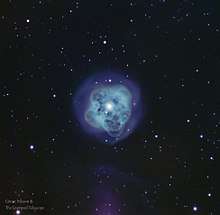NGC 1514
| Nebula | |
|---|---|
 | |
| Observation data: J2000 epoch | |
| Right ascension | 04h 09m 16.984s[1] |
| Declination | +30° 46′ 33.47″[1] |
| Distance | 2200 ly (700 pc)[2] ly |
| Apparent magnitude (V) | 9.43[1] |
| Apparent dimensions (V) | 2′.2 |
| Constellation | Taurus |
NGC 1514 is a planetary nebula that was discovered by William Herschel on November 13, 1790, describing it "A most singular phaenomenon" and forcing him to rethink his ideas on the construction of the heavens. Up until this point Herschel was convinced that all nebulae consisted of masses of stars too remote to resolve, but now here was a single star "surrounded with a faintly luminous atmosphere."[3] He went on to conclude "Our judgement I may venture to say, will be, that the nebulosity about the star is not of a starry nature".
It has since been conjectured that the nebula in fact envelops a tightly orbiting double star with a period of up to 10 days. Gas is presumably expanding away from the larger star of the pair.[4]
Notes
- 1 2 3 4 SIMBAD 2007
- ↑ Smith, H. (9 April 2015). "On the distances of planetary nebulae" (PDF). Monthly Notices of the Royal Astronomical Society. 449 (3): 2980–3005. arXiv:1409.3422. Bibcode:2015MNRAS.449.2980S. doi:10.1093/mnras/stv456.
- ↑ Herschel 1791
- ↑ Muthu & Anandarao 2003
References
- Herschel, William (February 10, 1791), "On Nebulous Stars, Properly So Called.", Philosophical Transactions of the Royal Society, 81: 71–88, Bibcode:1791RSPT...81...71H, doi:10.1098/rstl.1791.0006
- Hoskin, Michael A. (1963), "William Herschel and the Construction of the Heavens", Oldbourne History of Science Library, London: Oldbourne, Bibcode:1963whch.book.....H
- Muthu, C.; Anandarao, B. G. (December 2003), "A Spatiokinematic Study of the Planetary Nebula NGC 1514", The Astronomical Journal, 126 (6): 2963–2970, Bibcode:2003AJ....126.2963M, doi:10.1086/379552
- SIMBAD (2007), Results for NGC 1514, SIMBAD, Centre de Données Astronomiques de Strasbourg, retrieved September 14, 2007
- NASA (2010), WISE Image Reveals Strange Specimen in Starry Sea, National Aeronautics and Space Organization, retrieved November 19, 2010
External links
| Wikimedia Commons has media related to NGC 1514. |
Coordinates: ![]()